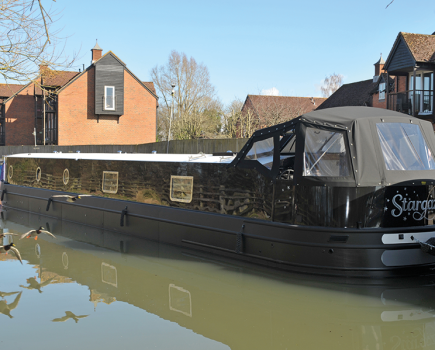It was an ambitious plan. Ninety-four locks over 111 miles around the Four Counties Ring in a week; that was the challenge that lay before our crew of five one drizzly Saturday afternoon in the Potteries. Picking our way through the mist-capped kilns, our chosen route for our ninth year out for a week in a narrowboat could not have seemed more daunting. Little did I know that just over 48 hours later I’d encounter one of the most memorable experiences of my life.

A sky full of stars
As an avid stargazer and life-long fan of everything in space, I am no stranger to a starry sky. I’ve been to some of the darkest skies in Europe, and to some of the furthest places in the universe with my telescope. But none of these experiences prepared me for the couple of nights I spent gazing at the stars from the roof of our narrowboat on this trip.
Night one gave me dazzling electric blue braids of light spread out across the northern part of my August sky from something known as a noctilucent cloud (NLC) display. It was by far the best and most persistent NLC display I’ve ever seen, all set against a sky full of stars. Night two topped that experience. Gently swaying on our boat in a light summer breeze, I was treated to a surprise burst of shooting stars from the Perseids Meteor Shower. More than a hundred flashes of light shot across the sky that evening in a little under 45-minutes of stargazing. It sure was incredibly dark that night out along the Shropshire Union. I’ll never forget the Milky Way on that second night either. It really caught the eye with dark rifts running like veins through its soft glow – and it got me thinking.
On the canals, we’re so fortunate to have easy access to a dark sky. Millions of people live in light-polluted towns and cities from where only a smattering of the brightest stars can be seen. But out along the more rural stretches of the UK’s canal network, we’re able to get away from that pervasive orange haze of urban streetlamps. The sky opens up, letting us peer out into a universe of distant fragile light.

Binoculars and telescopes show us more of this bizarre and fascinating night-world. With our eyes widened by their optics, our dark sky suddenly resolves into many tens of thousands of stars. Heaven’s grand designs are revealed in stunning detail; towering shards of ghostly gas denoting the birthplace of stars in our own galaxy, and countless clusters of coloured stars providing us with an insight into the lifecycle of distant suns.
It’s all there for us to see. We just need to know where to look.
How to Stargaze
Just looking up into the night sky with our eyes is the best way to get started on a stargazing adventure. Give yourself a good 10-15 minutes to let your eyes adapt to the darkness. You’ll see more and fainter stars that way.
For smartphone owners, there are a number of apps that will help you navigate your way around the stars, and help you find constellations and planets, all by simply holding up your phone to the sky. If you have a laptop or tablet, try downloading one of the many planetarium software programs available. Stellarium (stellarium.org) is a great place to start as it’s free.
Smartphone apps and planetarium software also give you access to a database of locations for numerous celestial objects that you can see with binoculars and telescopes. They are ideal stargazing tools to help beginners. Just bear in mind that the brightness of these objects varies massively. Before setting out on a search of the sky take note of the object’s stated magnitude on your app or planetarium software. As a ready-reckoner binoculars will get you down to objects of around 8th-9th magnitude, while a small telescope of 150mm aperture will resolve objects down to about 12th magnitude.
Need to Know
Standing underneath a starry sky often raises a lot of questions. We might wonder about our place in the universe, how far away the planets and stars are, and why on some nights we might see more in the night sky than on other nights. So here are some basic pointers to help you get to grips with your stargazing experience.
1. Everything is moving: Earth makes a full rotation on its tilted axis every 24 hours. As a consequence, the stars appear to move from east to west using the Pole Star as a pivot point. The Pole Star is easy to find sitting directly north at a height above the ground equivalent to the latitude of your location.
2. The darker the sky the more you’ll see: for a full-on starry sky experience you’ll need to be in a rural location away from main population centres and be prepared to venture out on a clear moonless night.
3. Think 3D; we all know that stars vary in distance from the Earth. Arcturus, the bright copper-tinted star high up in the south-west during July and August evenings, is 36 light years away. That’s relatively close when you consider that the Pole Star is 434 light years away and that the bright star Deneb in the constellation of Cygnus, which is high overhead on summer evenings, is a whopping 7,000 light years away.
What Can I See Tonight?
July is a great month to start exploring the night sky. One of the main attractions is the summertime Milky Way. What we’re seeing is the light from millions of stars deep within the plane of our own galaxy. This year, a full moon falls on 12 July. To get the best view of the Milky Way’s north-south band of light, it’s best to choose a night in the latter third of the month when the moon is waning.
Joining the Milky Way in the night sky this July are the planets Saturn and Mars. To find Saturn, look for a pale yellow ‘star’ no more than 20-degrees above the horizon to the south-west as soon as it gets dark. A telescope will show its rings and some of its moons.
The bright rusty-orange coloured star to the right of Saturn is Mars which is moving further away from Earth now in its orbit around the Sun. A telescope shows it as a small orange disc of light, on which eagle-eyed observers might get to see dark surface markings.
Beyond the planets, the summer sky bursts into life when using binoculars and telescopes. Close to the southern horizon lurks star-birth nebula, where new stars are being formed.
Countless star clusters are found along the spine of the Milky Way while, at the outer reaches of our galaxy, we find massed a strange collection of ancient celestial beasts called globular clusters.
So, on a clear evening, why not cast your gaze skyward this summer to take in the wonder and beauty? I know I will when I’m once again on the roof of my boat on a more relaxed jaunt than last year’s Four Counties marathon.
Image(s) provided by:
Archant







